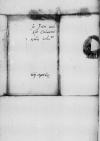Accepimus litteras Paternitatis Tuae, illis quoque inclusas has
, quas il paper damaged⌈[l]l paper damaged⌉lustris Hendrik III of Nassau-Breda (*1483 – †1538), son of Count Johann V of Nassau-Dillenburg and Elisabeth of Hessen, married to Mencia de Mendoza, Marquess of Zenete, daughter and heiress of Rodrigo Díaz de Vivar y Mendoza, first Marquis of Zenete; Count of Nassau; from 1499 in the service of Archduke Philip of Habsburg as his advisor and military commander in the wars against France and Gueders (1507, 1514), 1515-1522 Stadtholder of Holland and Zeeland; 1521 Grand Chamberlain of Charles V of Habsburg (from 1522 to 1529 at the Spanish court), in 1530 followed Charles V to the coronation in Bologna, and attended the Diet of Augsburg (CE, vol. 3, p. 5)⌊comes a NassauHendrik III of Nassau-Breda (*1483 – †1538), son of Count Johann V of Nassau-Dillenburg and Elisabeth of Hessen, married to Mencia de Mendoza, Marquess of Zenete, daughter and heiress of Rodrigo Díaz de Vivar y Mendoza, first Marquis of Zenete; Count of Nassau; from 1499 in the service of Archduke Philip of Habsburg as his advisor and military commander in the wars against France and Gueders (1507, 1514), 1515-1522 Stadtholder of Holland and Zeeland; 1521 Grand Chamberlain of Charles V of Habsburg (from 1522 to 1529 at the Spanish court), in 1530 followed Charles V to the coronation in Bologna, and attended the Diet of Augsburg (CE, vol. 3, p. 5)⌋ transmisit vertique eas in Latinum curavimus, ex quibus omnia, quae per nos exspectabantur, plane intelleximus. Gratum nobis exstitit, ut quae habemus in hoc negotio quam plures tractatus explicare animum nostrum valeamus et amplecti tandem, quod potiu text damaged⌈[u]u text damaged⌉s fore iudicabimus. Tua igitur Paternitas quemadmodum suo Marte hoc negotium proposuit, ita eodem quoque illud absolvat, hac quippe condicione interposita, ut de nobis vel minimum praesumi non possit, quo hoc negotium tractari written over e⌈eii written over e⌉ per nos coeptum sit, nostrae si quidem auctoritati non parum detrahi videretur, confidimus tamen hoc dexteritati Paternitatis Tuae.
Venerabilem Tiedemann Giese (Tidemannus Gisius) (*1480 – †1550), in 1519 ennobled by King Sigismund I; 1504-1538 Canon of Ermland (Warmia); 1516-1527, 1533-1537 Judicial Vicar and Vicar General of Ermland; 1523-1538 Custos of Ermland; 1537-1549 Bishop of Kulm (Chełmno); 1549-1550 Bishop of Ermland (BORAWSKA 1984, passim)⌊custodem VarmiensemTiedemann Giese (Tidemannus Gisius) (*1480 – †1550), in 1519 ennobled by King Sigismund I; 1504-1538 Canon of Ermland (Warmia); 1516-1527, 1533-1537 Judicial Vicar and Vicar General of Ermland; 1523-1538 Custos of Ermland; 1537-1549 Bishop of Kulm (Chełmno); 1549-1550 Bishop of Ermland (BORAWSKA 1984, passim)⌋, quem nobis commendat Paternitas Tua, illius virtutis et intercessionis Paternitatis Tuae rationem libenter habebimus faciemusque apud sacram Sigismund I Jagiellon (Zygmunt I) (*1467 – †1548), King of Poland and Grand Duke of Lithuania (1506-1548); Duke of Głogów (Glogau) (1499-1506), Duke of Opava (1501-1506), Governor of Silesia (1504-1506); son of King Kazimierz IV Jagiellon and Elisabeth of Austria⌊regiam maiestatemSigismund I Jagiellon (Zygmunt I) (*1467 – †1548), King of Poland and Grand Duke of Lithuania (1506-1548); Duke of Głogów (Glogau) (1499-1506), Duke of Opava (1501-1506), Governor of Silesia (1504-1506); son of King Kazimierz IV Jagiellon and Elisabeth of Austria⌋ commendatum illum. Remittimus etiam litteras illas, quas a nobis remitti Paternitas Tua postulavit.
Quae bene valeat.


 BCz, 3465, p. 266
BCz, 3465, p. 266